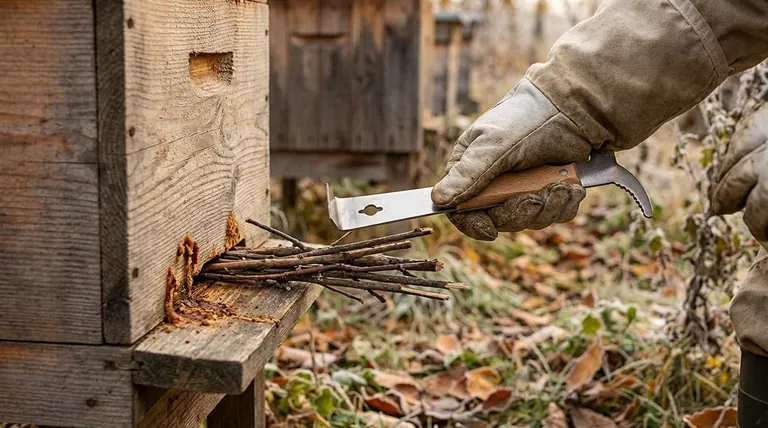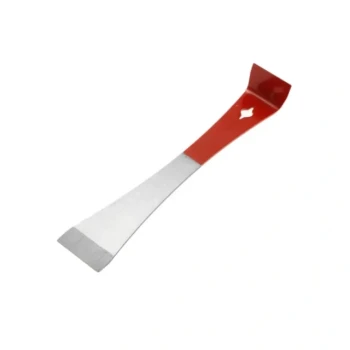To help bees regulate hive temperature, a beekeeper can gently insert a bundle of small sticks into the hive entrance if the colony has not reduced it by late autumn. This technique does not seal the entrance but provides a framework that the bees can then choose to close with propolis or leave open for ventilation, giving them precise control over their environment.
The core principle is to assist, not to take over. While most bee colonies are genetically equipped to manage their own hive entrance for winter, occasional, non-intrusive support can help them better control temperature and ventilation when they fail to do so on their own.

The Principle of Hive Entrance Management
Understanding why the hive entrance is so critical is the first step to providing effective support. It's the primary interface between the colony's controlled internal environment and the variable conditions outside.
The Bees' Natural Strategy: Propolis
Most honeybee colonies possess the genetic instinct to prepare their hive for winter. They gather resin from trees and plants to create propolis, a sticky, antimicrobial "bee glue."
They use this propolis to seal drafts, reinforce structures, and, most importantly, reduce the size of the hive entrance. This natural process is typically sufficient to protect the colony.
Why a Smaller Winter Entrance is Critical
A large, open entrance in cold weather creates two significant problems for a colony.
First, it causes substantial heat loss. The bees must consume more of their honey stores to generate the heat needed to keep the winter cluster warm, increasing the risk of starvation.
Second, a large entrance is difficult to defend. Even in winter, the hive may be a target for mice or other pests seeking warmth and food. A smaller entrance is much easier for the guard bees to protect.
Practical Methods for Assisting Your Bees
If you observe that your colony has not taken action by late autumn, a couple of simple interventions can provide the support they need without disrupting their natural behavior.
The Stick Method: A Collaborative Approach
As the references suggest, the most effective method is to use a bundle of small sticks or twigs.
Gently push these sticks into the main entrance of the hive. The goal is not to plug it completely but to create a porous barrier.
This framework gives the bees a head start. They can then easily use propolis to seal the gaps between the sticks to their exact preference, allowing them to fine-tune airflow and temperature control far better than a solid block would allow.
Managing Upper Entrances
Some hive configurations include an upper entrance for ventilation during the hot summer months.
If this upper entrance is not being used by the bees as winter approaches, it can act like a chimney, drawing essential warmth out of the hive. You should close any unused upper entrances to prevent this heat loss.
Understanding the Trade-offs
Intervening in a hive always requires careful consideration. Acting incorrectly can cause more harm than doing nothing at all.
The Risk of Over-Intervention
The primary mistake is acting too early or too aggressively. Sealing a hive entrance yourself with a solid reducer takes control away from the colony.
If sealed too tightly, moisture from the bees' respiration can become trapped inside the hive. This condensation can lead to dampness, mold, and chilled bees, which is often more lethal than the cold itself.
Trusting the Colony's Instincts
Always give your bees the chance to manage the entrance on their own first. Your role is to be an observer.
Intervention is only warranted when the season has progressed well into autumn and the bees have shown no sign of reducing the entrance themselves. This indicates the colony may be weaker, smaller, or lacking the genetic drive to perform this crucial task.
Making the Right Choice for Your Colony
Your decision to act should be based on careful observation of your specific colony and the progress of the season.
- If your bees have already begun using propolis to narrow the entrance: Trust their process. Your best course of action is to simply monitor their work without interference.
- If it's late autumn and the entrance remains wide open: Gently insert a bundle of small sticks to provide a supportive framework for the bees to manage.
- If your hive has an unused upper entrance: Close it completely to prevent the "chimney effect" from drawing out precious warmth.
Your goal is to be a supportive partner, providing the right tools to help your bees thrive on their own terms.
Summary Table:
| Method | Purpose | Key Benefit |
|---|---|---|
| Stick Bundle | Provides framework for bees to propolize | Gives bees precise control over ventilation |
| Close Upper Entrances | Prevents heat loss from chimney effect | Reduces risk of colony chilling |
| Observation First | Allows bees to self-manage initially | Prevents harmful over-intervention |
Ensure your apiary thrives through winter with the right equipment. HONESTBEE supplies commercial apiaries and beekeeping equipment distributors with wholesale-focused operations, offering durable hive components and temperature management tools that support natural bee behavior. Contact us today to discuss bulk pricing and how our supplies can strengthen your colonies' winter readiness.
Visual Guide

Related Products
- HONESTBEE Professional Multi-Functional Hive Tool with Ergonomic Wood Handle
- Multi-Function Plier-Style Frame Grip Hive Tool
- Professional Dual-End Stainless Steel Hive Tool for Beekeeping
- HONESTBEE Professional Long Handled Hive Tool with Precision Cutting Blade
- Professional Stainless Steel Pry-Bar Hive Tool
People Also Ask
- What safety precautions are advised for beekeeping with hive tools? Master Safe Handling for Calm, Efficient Hives
- What tools are useful when transferring frames from a nucleus hive? Ensure a Smooth and Low-Stress Move
- Why do hive tools have a hole? Unlock the Secret to Efficient Beekeeping
- What types of hive tools are available for beekeepers? Choose the Right Lever for Your Apiary
- Why is it recommended to have multiple hive tools on hand? Essential Tips for Efficient Beekeeping



















